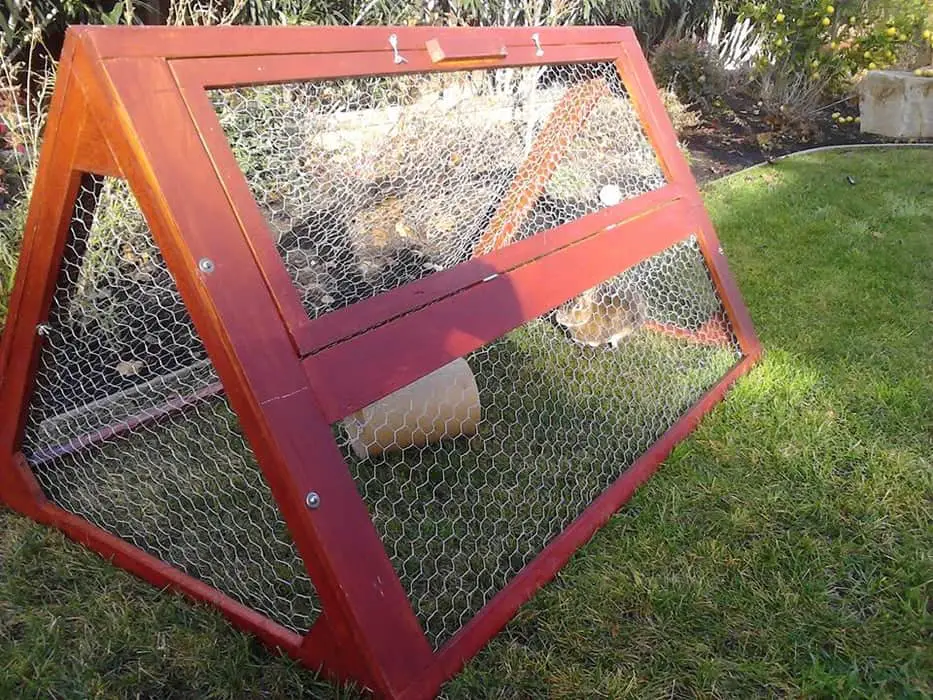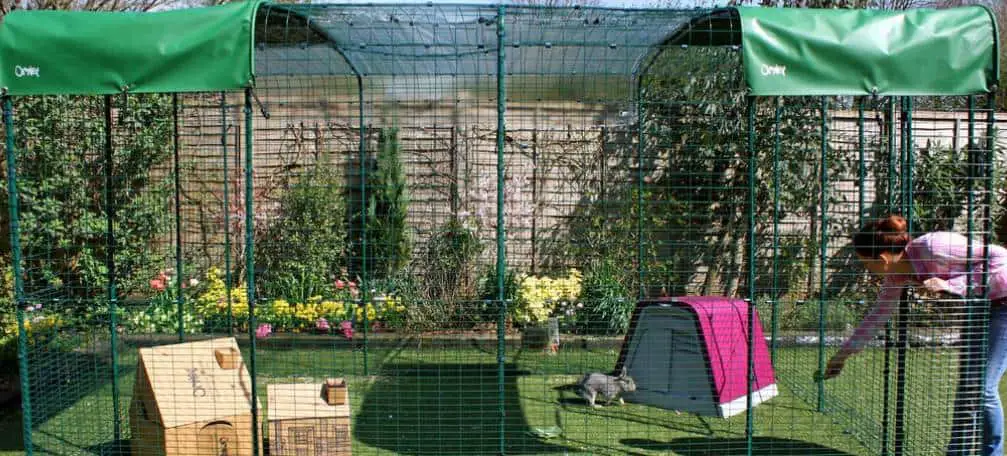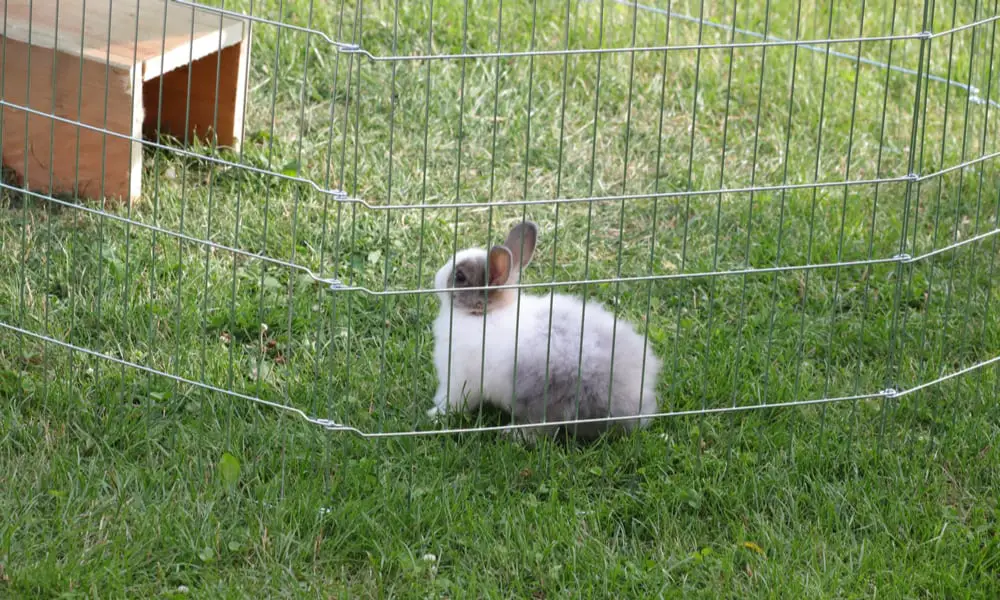Have you watched any bunny shots on wildlife documentaries? They’re usually on the B-roll, and you’ll typically see the rabbit raise its ears and be suddenly alert then take off running. A rabbit can sprint up to 45mph, so if you have a pet bunny at home, it needs lots of room to exercise if you want it to stay healthy and happy. Let’s explore ideas for a DIY rabbit run.
Table of Contents
1. Above Ground Rabbit Tunnels – Caged Free Range Rabbits
The simplest way to set up a DIY rabbit run is to use metal grates, cardboard, or Plexiglas. The metal grate can come from wire storage racks, hardware cloth, or X-pens, and they should be rigid, so chicken wire won’t cut it. You can raise it off the ground and add ramps.
To heighten the burrow-like atmosphere, you could drape dark fabric over the glass or wire. Pad the base so your bunny doesn’t hurt its feet while running. Cardboard tunnels are cheap and they don’t need covers, but they only last a few weeks before your bunnies destroy them.
2. DIY Cheap And Easy Portable Chicken | Rabbit Run – Eleven Gables

Like many sprinters, rabbits need a long runway to truly pick up speed. So if you’re building a DIY rabbit run, include uninterrupted stretches where they can really feel the wind. Sadly, that’s not always practical, and a mini-walkway is better than none at all, so here’s an idea.
This rabbit run isn’t as narrow as a rabbit would prefer, but it’s a wide wire box so they can still zip from one end to the other. If you plan to house the bunnies here permanently, bury a wire floor under the grass to prevent the bunnies from digging their way out and escaping.
3. Indoor-Outdoor Bunny Bench DIY Rabbit Run – Animal Cribs
A DIY rabbit run can be as simple or complex as you want. If your bunnies live inside the house, you can use X-pens, safety gates, and wire storage grates to create a pathway around the house for them to run. And you can build a pet door to extend the rabbit run outdoors.
Any open space will work as a rabbit run, but if you can build a long, narrow, tunnel-like run, your bunnies can reach their top speeds so they’ll be happy. You can use the upper sections of your rabbit tunnel for seating and entertaining, but make sure it’s accessible from above.
4. How to Build a DIY Rabbit Run – Raising Rabbits

If your bunny lives indoors with you, you probably worry that it doesn’t get enough sunshine and exercise. Maybe you like to take it out in the yard to play, but you’re worried it may run off or get lost, and it can be stressful supervising the rabbit as it enjoys its free rabbit recess.
You can solve this with an enclosed DIY rabbit run. It doesn’t have to be fancy – its purpose is to let your bunny stretch its limbs and gets its circulation going. A cage made of PVC and hardware cloth or fencing wire will do nicely since the rabbit won’t stay outdoors overnight.
5. How To Make A Simple Outside Rabbit Run – Way Out West
Rabbits are happiest when they can hop around in the sunlight and nibble on weeds and fresh grass. But farms come with predators, so it’s best if the bunnies sleep in a locked cage. During the day though, you can jerry-rig a playpen to serve as a temporary DIY rabbit run.
Sandra and Tim made their rabbit run out of four lengths of hardware cloth held together with zip ties. But you could also use X-pens, wire storage racks, or stiff mesh grids and J-clips. Include a hidey hole and leave the roof and floor open. Now they can play in safety!
6. Knockdown Outdoor Rabbit Tractor

A rabbit tractor or chicken tractor is a lightweight wire enclosure that lets bunnies (or hens) graze in safety. It might have castors, but if not, it’s light enough to drag around the yard so it can let your rabbits run around and get some exercise. They typically have no floors though.
So you shouldn’t leave the rabbit in the tractor unsupervised because it may dig its way out and escape. Worse, a predator might burrow its way in! And remember, these tractors are for daytime use only. After dark, the bunny needs to go back indoors, or into a lockable hutch.
7. New DIY Rabbit Cage With Tunnel System – 101 Rabbits
DIY rabbit runs are mostly installed outdoors. We’ve mentioned how indoor bunnies can have a pathway assembled from pet gates and wire storage grates. But you can incorporate rabbit runs into your rabbit room as well. Set up a few cat tunnels or covered rabbit ramps.
These hollow spots mimic burrows so your rabbit will love running through them. Tunnels can range from wide springy pipes to long wooden boxes that are covered on all sides. You can put a carpet inside the tunnel for traction, or have holes on the sides to let some light in.
8. Build A Rabbit Hutch And Tractor – Self-Reliance

Female rabbits (does) can’t sleep in a bunny tractor because they’ll get the urge to dig their way out. Male rabbits (bucks) are less likely to dig, so if you don’t have burrowing predators and the weather is nice, they can stay in a wire bunny run for the night or even the weekend.
Still, to ensure your bucks are comfy, include a wooden hidey hole so they have some privacy. The hidey hole needs a solid floor to keep rabbits off the wet grass on dewy mornings. Install a metal or plastic corrugated roof to protect your bunny buddy from rain or strong sunlight.
9. DIY Outdoor Rabbit Run (Garden Enclosure for Exercise)
If you don’t have enough space for a rabbit hallway or a bunny corridor, you can set up a square rabbit run. Just make it big enough for the bunnies to work up a sweat running along the perimeter or zipping from corner to corner. This one is made of mesh and wood frames.
You can color the wood, but ensure any paint or stain you use is safe for animals, especially since bunnies love to chew through wooden doors, frames, or window trim. This DIY rabbit run can be accessed from the top and the side, but the bunnies never sleep in it at night.
10. How to Build a Rabbit Run – WikiHow

As you work on your DIY rabbit run, ensure you use metal grids that are rigid and galvanized to prevent warping or rusting. But any UV coating or anti-corrosive protection has to be safe for rabbits in case they nibble on the metal or inhale the fumes. You can use different metals.
We’ve already listed hardware cloth, mesh grids, exercise pens, and wire storage shelves. But you can buy a ready-made wire cage and connect the walls with J-clips or cable ties. Another suggestion is to use the aviary panels that are used to make bird cages. Just pad the flooring.
11. Canadian Outdoor Easy to Build Rabbit Run – Ferreri Info
Are Canadian rabbit runs different from American ones? Not really. US residents prefer to use stiff wire on theirs, simply because softer wire will sag when a bunny leans on it. But since this is a bunny run rather than a hutch, the rabbits won’t play in there unsupervised.
So chicken wire is a suitable alternative, and it’s much cheaper than mesh grids. Just make sure the chicken wire doesn’t have any of its sharp bits exposed since they could scratch your bunny. This DIY rabbit run is 8 feet by 8 feet and 3 feet high. That’s plenty of running room.
12. DIY Omlet-Styled Rabbit Run

If you’re from New Zealand, you may have heard of Omlet Rabbit Runs. These fancy green rabbitats (rabbit habitats) are sleek, stylish … and expensive! But you can make something similar at home using more pocket-friendly materials. The framing resembles a greenhouse.
It has a pitched roof and tall sides, so you can use wood frames or PVC poles with elbows to support the structure. Then instead of covering the ‘greenhouse’ frame with glass or plastic sheeting, use metal grids to cover the sides of your rabbit run. The tarp roofing is optional.
13. Rabbit Burrow DIY with 5 Gallon Bucket – Be Not Slothful
In this video, a plastic bucket with a hole in the lid is loaded with soil and partially buried to make a convincing bunny burrow. To turn this burrow into a bunny run, you need to extend it lengthwise. Do this by laying several buckets end-to-end in a long row to make a tunnel.
You can then dig a trough and bury this bunny pipeline to make a DIY rabbit run. The front bucket will have a lid and a hole, but all the buckets behind it will be lidless and have their bottoms cut out to keep the tunnel hollow. Option two is using 20” PVC or old ceramic pipes.
14. Setting up an Outdoor Rabbit Space – Cape Coop

Most of the DIY rabbit runs we’ve looked at so far were temporary. The bunnies only play in them during the day, but sleep elsewhere in a secured hutch. But what if you want a more permanent bunny run? You can upgrade the space outside their hutch by adding essentials.
Bunnies love to rush across open ground, but they’re happier if they’re covered since it feels like an underground burrow. Mimic this idea with tube-like structures such as hollowed-out logs, broad PVC pipes, beer barrels, upside-down water troughs, and synthetic cat tunnels.
15. Rabbits Runaround – Nitu’s Rabbits
We’ve mentioned Omlet rabbit runs from New Zealand, but the company also makes rabbit tunnels. And if you live in the UK, you can get something similar from Excel Runaround. It’s a modular setup that connects hutches and wire cages with accordion pipes and Plexiglas.
For US citizens, you can construct something similar. Go to the hardware store or talk to a plumber and they’ll tell you where to find wide accordion pipes. You can link several of these pipes together or order a really long one. Align it to make a fun, protective DIY rabbit run.
16. Expand Your Rabbit Housing – Rabbit Runaround Tunnels

We started this list with a series of interconnected rabbit runs that were raised off the ground. It’s a clever way to give your bunnies more running space if you have a small yard. But what if you want your rabbit runs on ground level? You can easily adjust your setup.
You’ll need rolls of rigid wire grids that you can coil into cylinders. Run them around the yard to maximize your rabbit runway. Use zip ties to hold these wire tunnels together, and plant grass or pack sod at the ground level to create softer padding for your bunnies’ feet.
17. The Best Outdoor Rabbit Run // Aivituvin Rabbit Hutch Review
What if you don’t want to construct your bunny run from scratch? If you’re willing to spend about $200, you can order a flat-pack bunny hutch with a rabbit run built-in. With modular brands like Aivituvin, you can buy extra pieces and add them on to lengthen the bunny run.
In this case, you would construct the enclosed section then buy additional wire gates so you can stretch the bunny run and form a much longer runway. If the rabbits live outdoors, you’ll have to bury a wire grate two feet below the dirt. Otherwise, bring your bunnies in at night.
18. Rabbit Run Obstacle Course – Pinterest

You might prefer a hands-off rabbit run. One that doesn’t require any chopping or sawing. And if yard clutter doesn’t bother you, you can collect everything you need at the local junkyard. You’re looking for things with holes in them, so any cylindrical item will do the job.
You can grab old planters, broken ceramic pots, PVC pipes, slotted building blocks, hollow logs, or sideways water tanks. Scatter these around the yard then frame the perimeter with fencing wire. Your rabbits will get tons of exercise running from spot to spot as they explore.
19. DIY Rabbit Burrows For Meat Rabbits!
This final DIY rabbit run was built for commercial rabbits that live in a wire enclosure. As you can see, the does are digging away to make safe spots for their incoming babies, and if there wasn’t a wire barrier buried under that rabbit colony, those bunnies would be gone!
But how can you apply this at home? If you don’t mind digging up your backyard, you can make a series of bucket burrows and connect them with long PVC pipes. If you place a 5-gallon bucket at either end of all the pipes, you can craft a lengthy network in a small space.
Do you have a DIY rabbit run at the moment? Show us your photos in the comments section!

